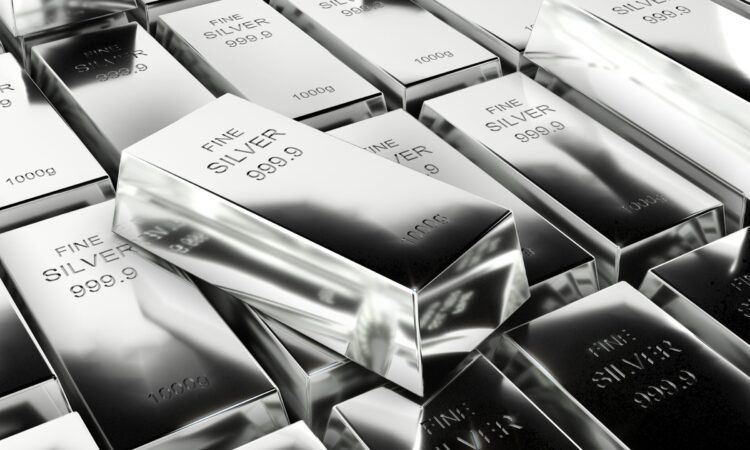
What is the current price of silver today?
The price of silver opened at $28.87 per ounce, as of 9 a.m. ET. That’s down 2.34% from the previous day and up 20.65% year to date.
The lowest trading price within the last day: $28.57 per ounce. The highest silver spot price in the last 24 hours: $29.56 per ounce.
Silver spot price
The spot price refers to the price at which silver can be bought or sold “on the spot,” or immediately. The futures price, on the other hand, reflects the price for silver delivered later.
Silver’s spot price in U.S. dollars is denoted as XAG/USD on the foreign exchange market. You can track silver’s spot price in other currencies, including XAG/GBP for British pounds and XAG/EUR for euros. Silver trades 24/7, so its price is always shifting.
Silver price chart
This chart shows how silver’s spot price has trended over the last year. The data is updated at 9 a.m. ET and doesn’t have intraday lows or highs.
As of 9 a.m. ET, silver was up 20.65% since Jan. 1. It hit its 52-week high of $32.51 on May 19, 2024. The 52-week low was $20.69 on Oct. 2, 2023.
The spot price represents the current market rate, or what the price is “on the spot.” Like gold prices, silver prices are typically provided in troy ounces. One troy ounce equals 1.097 standard ounces.
Various factors drive spot prices for silver. Many investors opt to trade using futures contracts rather than spot prices.
Precious metals prices
Silver is one of four main precious metals investors can trade via physical bullion, exchange-traded products or futures contracts. Gold, palladium and platinum spot prices are also updated 24/7 in a variety of currencies.
Gold/silver ratio
The gold/silver ratio is the price of an ounce of gold divided by the price of silver per ounce. As of today, the gold/silver price ratio is 80.03.
This is an important tool for comparing the value of gold to the value of silver over time. A higher ratio means gold is trading at a premium to silver. That can often be a sign of economic uncertainty. A lower ratio means silver prices are gaining on gold prices.
Silver price history
Silver prices peaked in January 1980 at $49.45 per troy ounce. They hit a low of $3.56 per troy ounce in February 1993.
Silver’s spot price has fluctuated over the years. Variables such as supply and demand, geopolitical events, currency strength, economic data, and changes in investment trends impact silver prices.
1970 – 2005
Silver was under $10 per ounce in the mid-1970s. It reached nearly $50 in 1980. But silver fell back under $10 by the late 1980s.
2006 – 2024
Silver prices cleared $10 again in 2006.
The Great Recession drove prices higher. In March 2008, spot prices reached about $20 per ounce. But another sharp decline followed. Silver dropped back below $10 by October 2008.
Another major jump occurred a few years later. In April 2011, silver traded at over $45 per ounce.
Silver future prices
Global exchanges exist in cities such as London, Hong Kong, Zurich, New York and Chicago. They allow for nearly 24-hour silver trading. The COMEX plays an essential role in setting silver spot prices. This branch of the Chicago Mercantile Exchange uses futures contracts to project silver prices.
Silver futures are contracts to buy or sell silver for a set price at a set future date.
Silver ETPs
Do you want to invest in silver using your normal broker? Then you might consider exchange-traded products. ETPs have ticker symbols and trade like stocks on exchanges. They typically hold physical bullion stored in audited facilities. Shares represent ownership of a fraction of that silver.
Note that ETPs may have management fees. They may also have tracking errors relative to silver’s spot price.
Investing in silver
Investing in silver can be approached in several ways, each with unique benefits and considerations:
- Bullion. This direct method involves owning physical silver bars and coins. But investors must consider storage and insurance costs, dealer markups, and the bid-ask spread when buying and selling.
- ETPs. These are available in most brokerage accounts and offer a more accessible alternative. But investors face ongoing annual expense ratios and possible tracking errors relative to the spot price of silver. It’s important to note that redeeming shares for physical silver is only sometimes guaranteed.
- Futures.Futures allow for speculation or hedging against price movements. Trading these derivatives is done on margin, making it highly volatile and potentially unpredictable. It requires a thorough understanding of the market and its risks.
Is silver a good investment?
Various economic factors affect silver’s price movement. Your objectives, risk tolerance and time horizon also impact whether silver is a good investment.
Silver is one way to diversify a portfolio that includes stocks and bonds. But it can be volatile and risky. Consider your options before investing in silver.
Frequently asked questions (FAQs)
Gold is rarer than silver.
A precious metal’s rarity can be understood through its mass fraction. This indicates how much of the metal can be found per billion kilograms of Earth’s crust. Gold is present at four parts per billion, compared to 75 parts per billion for silver.
Investors can gain silver exposure in their IRA through two main methods. One way is by including silver ETPs in their individual retirement account. This method allows investors to have an investment linked to silver without needing physical storage.
Alternatively, investors can use a silver IRA provider to open a specialized IRA that holds physical silver. In this case, the investor’s IRA invests in silver bars or coins stored in a secure, IRS-approved depository.
The process requires choosing a custodian that specializes in self-directed IRAs to manage the purchase, storage and security of the physical silver.






